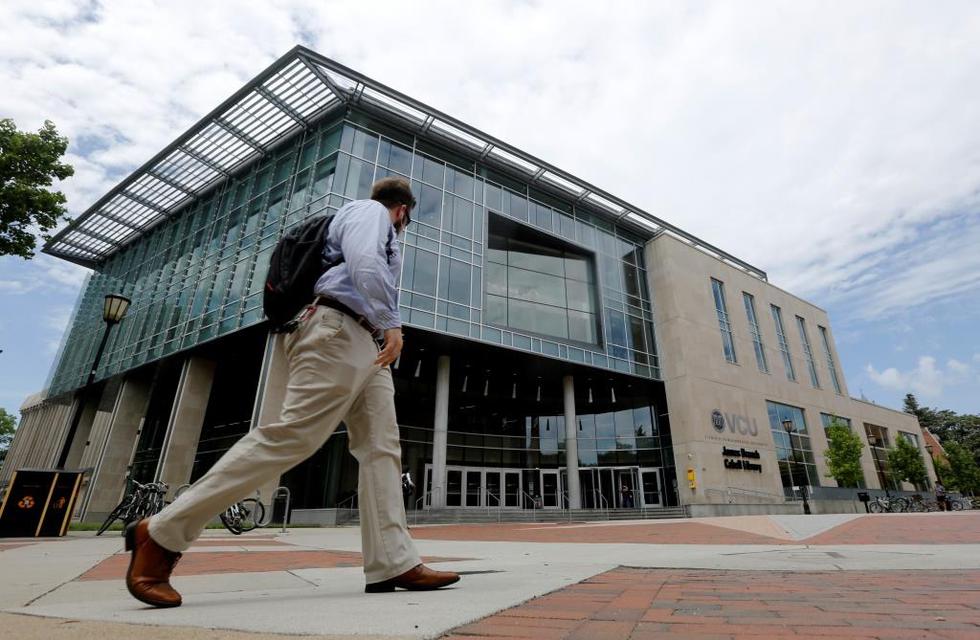
Steve Helber/AP Photo
A student on the campus of Virginia Commonwealth University, June 20, 2019, in Richmond, Virginia
This story is part of the Prospect’s series on how the next president can make progress without new legislation. Read all of our Day One Agenda articles here.
The Prospect has already documented how a president can use existing statutory authority to cancel nearly all student debt. For their part, Sens. Elizabeth Warren and Chuck Schumer have come out with a proposal for Joe Biden to use this authority to cancel $50,000 worth of debt.
But a new report out now from Michael Dannenberg, vice president of higher education policy at Education Reform Now, argues that Biden can do even more to transform the landscape of higher education. Debt, after all, is only one piece of the puzzle. Even if current debt is canceled, debt will keep accruing if the costs of college continue to rise. Dannenberg, a former senior aide to the late Sen. Ted Kennedy, asserts that Biden can use existing statutory authority to forgive loans equal to average public-college tuition on a rolling basis for two- and four-year public colleges, effectively making college free. In essence, this is an idea that Biden can use to make his plan for tuition-and-fee-free college a reality—without Congress.
“I’m suggesting that there are multiple paths for the Biden administration to pursue without Congress that can make an up-front guarantee of tuition-and-fee-free public college a reality,” Dannenberg said in an interview with the Prospect. “It can be done through a negotiated rulemaking process that is grounded in the settlement and compromise authority to cancel a portion of student debt. It can be done through the use of the secretary of education’s experimental site authority to again effectively or immediately cancel a portion of federal student loan debt. It can even be done through an agreement with the Federal Reserve whereby it acquires and writes down student debt.”
Dannenberg previously wrote about the rising cost of college tuition for the Prospect in 2009, when he recommended treating “student loans as social insurance with limited monthly payments.” In 2013, Dannenberg added to this thesis, suggesting several options for combating debt for low- and middle-income families.
Now, Dannenberg says there are several ways the Biden administration could make free college a reality without Congress. The Higher Education Act, in addition to providing statutory authority to waive student loans, also provides the authority to waive legal requirements and regulations for “experimental sites” where the government tests ways to improve higher education. According to Dannenberg, there’s no limit on the size of such a site. In other words, the secretary could designate a public university such an experimental site, thus providing for debt forgiveness. This route, he added, would make it easy for the Biden administration to “leverage complementary college behavior.” To Dannenberg, this would be the cleanest executive action pathway to make the Biden higher education plan a reality.
With either model, it would effectively mean the government is paying a lot of tuition, and colleges might have incentives to raise costs, since students won’t be paying but the Education Department would. The government would have to guard against this, perhaps by limiting eligible colleges to a narrow band around the median tuition.
“There’s been a lot of energy to date with regards to executive action on the student loan issue, focused on current borrowers who have outstanding debt,” Dannenberg noted. “What I’m saying is that that same thought process can be applied to prospective student loan borrowers or to future students to effectuate the Biden tuition-and-fee-free college proposal.” He recommends making these loans—that would all be forgiven—equal in amount to the national average public-college tuition, currently around $10,000 annually for four-year public colleges and around $4,000 for two-year public colleges.
Though there is a debate about whether debt cancellation should be means-tested, Biden’s college plan answers that question: His proposal offers tuition-and-fee-free college to students from families earning up to $125,000. “I think in general one can and should reject the notion that college affordability plans must be limited only to poor families,” Dannenberg said. “But we should also recognize that additional resources for college and affordability are arguably limited. Better to provide a much larger progressive need-based package of college affordability and completion support than a small regressive package that’s available to all students.”
Biden’s proposal offers tuition-and-fee-free college to students from families earning up to $125,000.
Like other advocates for student debt forgiveness, Dannenberg pointed out that such a measure would also help close the racial wealth gap. Almost 50 percent of Black student loan borrowers default over a 12-year period. Worse, around one in four Black bachelor’s degree recipients will default. These two numbers, Dannenberg said, are the most obscene in higher education.
Politically, Dannenberg sees these executive actions as part of a strategy to put Biden in a position of strength when negotiating with congressional Republicans. Taking aggressive executive action to further Biden’s agenda could force the GOP to come to the table.
Dannenberg suggested that there’s even more Biden could do to level the playing field in higher education without Congress. For example, he could end tax-exempt status for colleges that “favor big donors, known as ‘development admits,’ and [admit] children of alumni via the so-called ‘legacy preference,’” programs that effectively discriminate against first-generation applicants.
“This is my big point. A 100 percent forgiven student loan is functionally the same as a grant,” Dannenberg said. “And current law authorizes student lending and 100 percent forgiveness. President Trump’s administration already made use of that legal authority to suspend student loan payments.”



